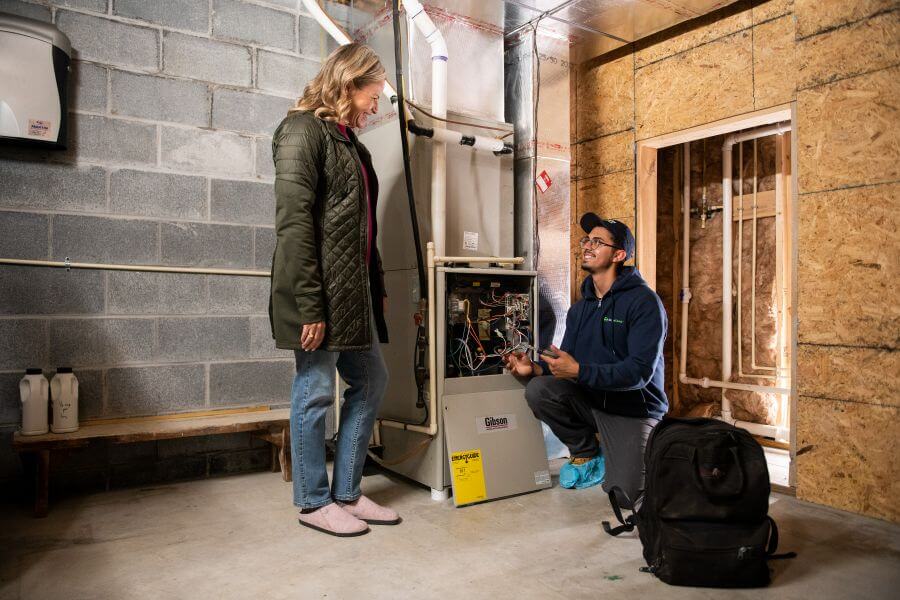
During the chilly winter months, your furnace is supposed to keep your home warm and cozy. This is an easy job when your heating system runs at its peak efficiency. However, when your furnace isn’t properly cared for, it directly impacts its ability to perform at its best. In some cases, improper maintenance can lead to your furnace sustaining damage or a need for a new unit entirely.
Below, we’ll talk about some of the main factors that affect your furnace’s efficiency and how to perform proper maintenance, so your furnace can keep you and your family warm during the cold season.
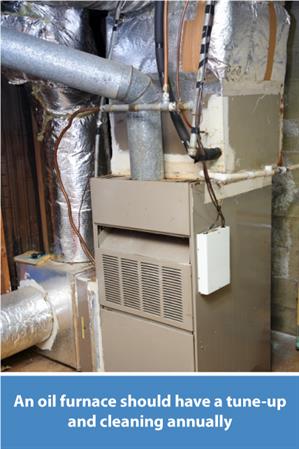
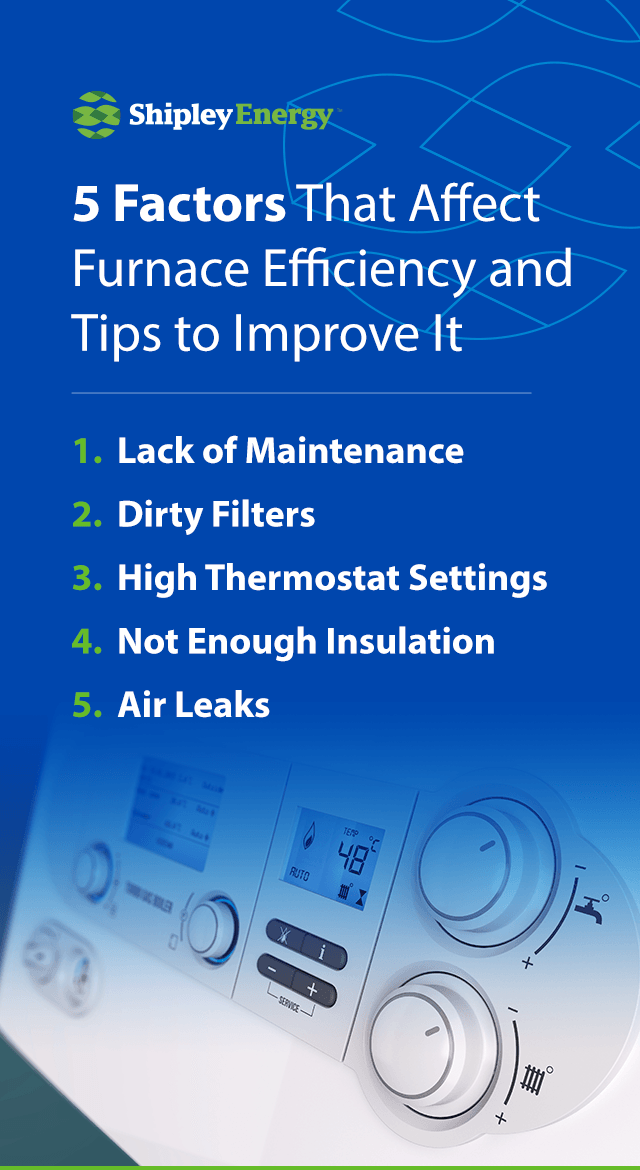
Regular maintenance helps ensure your furnace will run as efficiently as possible. Your furnace can sustain damage over the years, and it can be challenging to find solutions to these problems without the assistance of a professional. Repairs can be costly, and if the damage becomes severe enough, a replacement may be necessary. Regular maintenance can catch simple issues early and prevent more serious problems later. A consistent maintenance routine can help you get the most out of your heating system when the cold season rolls around.
You could also create a safety hazard when you don’t perform maintenance often enough. Carbon monoxide leaks can develop from an inadequate air supply or damaged parts in your heating system. The buildup can be hazardous to the inhabitants of your home. Carbon monoxide poisoning causes serious health complications and, in the most severe cases, death.
You can maintain your furnace efficiency by scheduling annual maintenance appointments with a professional. They can check your filtration system and determine whether any damage is present. They’ll be able to recommend the best plan of action for fixing any broken parts. Regular maintenance can also reduce the amount of damage your furnace sustains, so your heating system runs efficiently for as long as possible.
You can also practice maintenance at home between your annual checkups to ensure your furnace is in good working order.
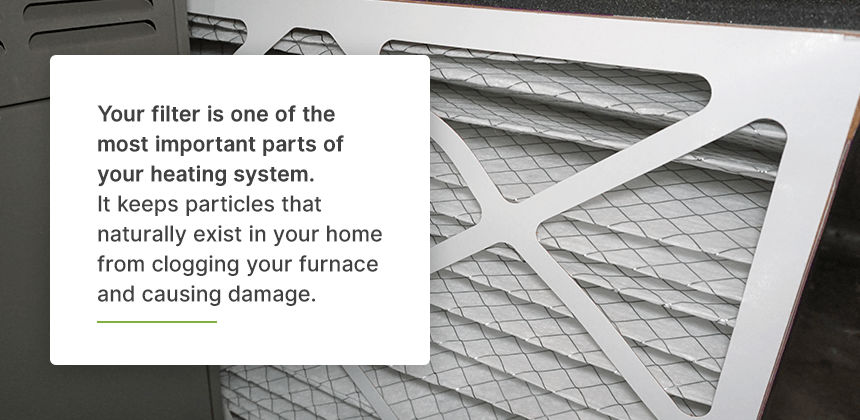
Your filter is one of the most important parts of your heating system. It keeps particles that naturally exist in your home from clogging your furnace and causing damage. Dust, pollen and mold are common particles in many homes, and air filters keep these particles from interfering with your heating system.
If you have pets, pet dander or fur likely exists in the air as additional particles that require filtration. Apart from keeping your furnace in working order, your filtration system helps eliminate these particles from the air to maintain good indoor air quality for your home.
When your furnace filter gets dirty and regular airflow is blocked, your furnace or heating system will need to work harder and consume more energy than usual to produce the same level of heat. When your furnace is putting in all this extra work, it drives up the cost of your utility bill and can add up significantly over time. Dirty filters can also allow carbon monoxide to leak into the air, impacting your home’s air quality and affecting the health of everyone who lives there.
You can prevent this by taking measures to clean furnace filters regularly. During the warm season, you should be changing your filter a minimum of once every three months. However, you should change your filter once each month in the cold seasons to achieve maximum efficiency. Your home can maintain its warmth, and your heating bill will remain low. Clean filters can also keep your system working longer and more efficiently while keeping the air clean.
You can find filters in most home improvement stores, and you can easily replace and install them on your own. Be sure to determine which filter you need by examining your current filter. Remove it from its slot and look along the frame for a printed size number. This indicates what filter size you’ll need to buy when shopping for a new one.
Everyone has different preferences when it comes to their home temperature. Some people prefer warmer temperatures, while others thrive in cooler environments. Some temperatures are better than others when it comes to reducing your energy bill and optimizing the efficiency of your HVAC unit. Cooler temperature settings in the winter are often best for increased energy efficiency, keeping your heating bill low and reducing strain on your heating system.
A temperature of approximately 68 degrees Fahrenheit is recommended to keep your heating bill as low as possible. You should also consider setting your thermostat to a lower temperature when you’re away from home or sleeping. Running your heating system just 7 degrees below your ideal temperature during these times can save you up to 10% a year on heating costs.
You’ll also keep your furnace or heating system from being overworked when away at work or cuddled under the covers at night. Sleeping in colder temperatures may not seem appealing at first, but studies show that the quality of your sleep is improved when the temperature is kept low during these hours. Your body naturally cools down during the night as part of your circadian rhythm, so sleeping in a colder environment assists with this process and reduces the chances of a disrupted sleep cycle.
Many modern thermostats let you schedule a time to lower the temperature automatically. Ideally, you’ll want to develop a schedule best suited to your lifestyle. Before you go out each day, lower the temperature in your home at least 20 minutes before you plan to leave.
You can have this programmed into your thermostat if you work a consistent schedule each day. You can also set your thermostat to increase the temperature in your home 20 minutes before you return home, so your house is warmed up by the time you return. If you go to bed and wake up around the same time each day, have your thermostat set to reduce the temperature about an hour before you go to sleep and increase the temperature half an hour before you wake up.
Smart thermostats allow you to set a schedule and have the additional benefit of determining when it’s the best time for your system to shut on or off. Some can even run diagnostics to determine if your furnace or heating system is encountering a malfunction. This helps you catch any problems early, so you can call a professional and run maintenance on your system so it can continue to run efficiently for years to come.
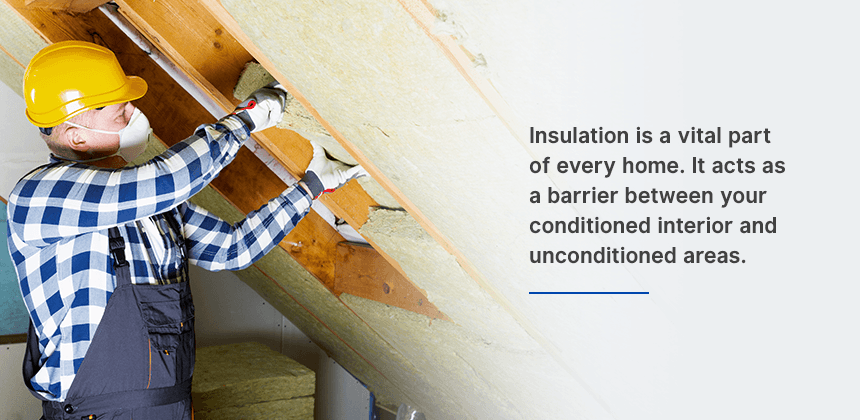
Insulation is a vital part of every home. It acts as a barrier between your conditioned interior and unconditioned areas. Insulation also protects your home from outside elements, such as cold weather, wind and excess moisture. When your insulation isn’t properly installed or not enough insulation was provided when your home was built, it can be challenging for your home to retain heat. Your furnace will have to work harder to make up for the lost heat as a result.
Insulation can also deteriorate over time due to the elements, pest infestations and old age. This means that your furnace will start working harder a little bit at a time, which can be difficult to notice right away. That’s why it’s essential to ensure your home is adequately insulated and replace insulation when it becomes damaged.
Different types of insulation last for various amounts of time. Some insulation types can last up to 30 years, while others can last a lifetime. Most types of insulation can experience degradation as soon as 15 years after installation.
Here are a few signs to look out for that might indicate new insulation is necessary:
Call a professional if you believe your insulation may need to be replaced. They can help you determine if your insulation has been damaged or if more insulation needs to be installed or replaced. They can also handle the installation process for you.
Effective insulation will help your home retain heat, so your furnace doesn’t have to work as hard, especially in the winter months. You can even use decorative forms of insulation in various rooms, such as rugs or carpets, to prevent drafts and make your home feel warmer. Being proactive and taking the necessary steps to ensure your home is insulated correctly will help your furnace remain efficient and keep it running strong for a long time.
Air leaks can happen in any home. Even the most well-designed homes can fall prey to occasional air leaks. Since warm air naturally travels toward colder temperatures, heated air can escape out of these gaps, and your furnace will have to work harder to keep your home adjusted to the set temperature. This strain on your furnace limits its ability to run efficiently and can result in damage over time, meaning you will need to replace the unit sooner than expected.
Air leaks often happen due to cracks or damage on windows, doors, ceilings, walls and attics. Garages can also be a major location for air leaks when your garage door isn’t sealed properly. Old or worn-out air ducts can cause air to leak out of your home, so it’s crucial to have your ventilation system checked to determine if any leaks are present.
If you suspect an air leak might be possible, there are a few methods you can use to find one:
Sealing air leaks in your home can save you up to 15% on your monthly heating bill. Your furnace won’t have to work as hard to heat your home’s interior, so you can save money and extend your heating system’s life span.
Your furnace keeps your home warm and comfortable during the cold season, so it’s essential to ensure it’s well maintained and functioning correctly. Part of what makes a furnace efficient is the energy it uses to run. Whether you’re using natural gas, oil or propane, quality energy keeps your furnace up and running when you need it most.
Shipley Energy can provide you with the energy you need to keep your home heated in the winter. We even offer repair services, so you can rest assured knowing your heating system is fully operational. We provide multiple service options across numerous states in the northeastern United States, so you can find a plan suited to your budget. Get started today by filling out our online contact form or give us a call at 1-800-839-1849.

Shout out to Service Tech Dave from York for his service call on Friday. After two previous techs were unable to fix our furnace, he spent 5 hours tracking down the problem. Extremely professional and friendly we were thrilled with his help.
Mark R.
I just wanted to Thank John who had to come out twice after hours for 2 problems with my furnace. He had the problems fixed in no time and was a pleasure! Great asset to the company!
Tracy K.
Lost our heat late Saturday afternoon-Derek called to say he’d be here by 6. He actually arrived and finished before that. He was very pleasant about having to travel to Lebanon on a Saturday evening. He explained what the problem was and how he solved it. He made s...
Read moreLost our heat late Saturday afternoon-Derek called to say he’d be here by 6. He actually arrived and finished before that. He was very pleasant about having to travel to Lebanon on a Saturday evening. He explained what the problem was and how he solved it. He made sure the furnace was functioning properly and that we had hot water before he left. Great job done in a pleasant manner!! Thank you!
Read less
My service was outstanding. Of course, I would expect nothing less from wonderful service techs. The ones who did the installation of my water heater, furnace, air conditioning and iwave were very knowledgeable and professional.
Ann C.
Having not used my furnace yet this season, I turned the heat on Sunday evening. The furnace kicked on, but emitted only cold air. Following my call, a technician arrived within the hour & I had heat in less than 30 minutes!
Kathy S.
I've been an oil customer of Shipley for years. This morning, I woke up to no hot water. Ran to work, took care of a few things and came home. Used the chat feature to request a service tech to come out. Super easy, and super quick to make a request for service. Tech ...
Read moreI've been an oil customer of Shipley for years. This morning, I woke up to no hot water. Ran to work, took care of a few things and came home. Used the chat feature to request a service tech to come out. Super easy, and super quick to make a request for service. Tech called me a few minutes later saying he was on the way. He arrived, fixed the problem - explained what had happened and was gone all within an hour of me making the online request. Amazing. Shipley - Wes was my technician today; and he is a very valuable member of your team. He represented your company very well. I could not be happier with his service.
Read less
Nothing is worse than going down in the basement to find your water heater burst and you have water all over your floor. What a mess. My family and I are thankful Shipley Energy was able to replace it so quickly. They even offered to come out on a Sunday to fix it!
Mike T.
Having a newborn baby and a child with asthma in the midst of global pandemic, I was constantly worried about germs and viruses. Thank you Shipley Energy for installing the iWave – it was a game changer for my family’s health and safety.
Madison H.